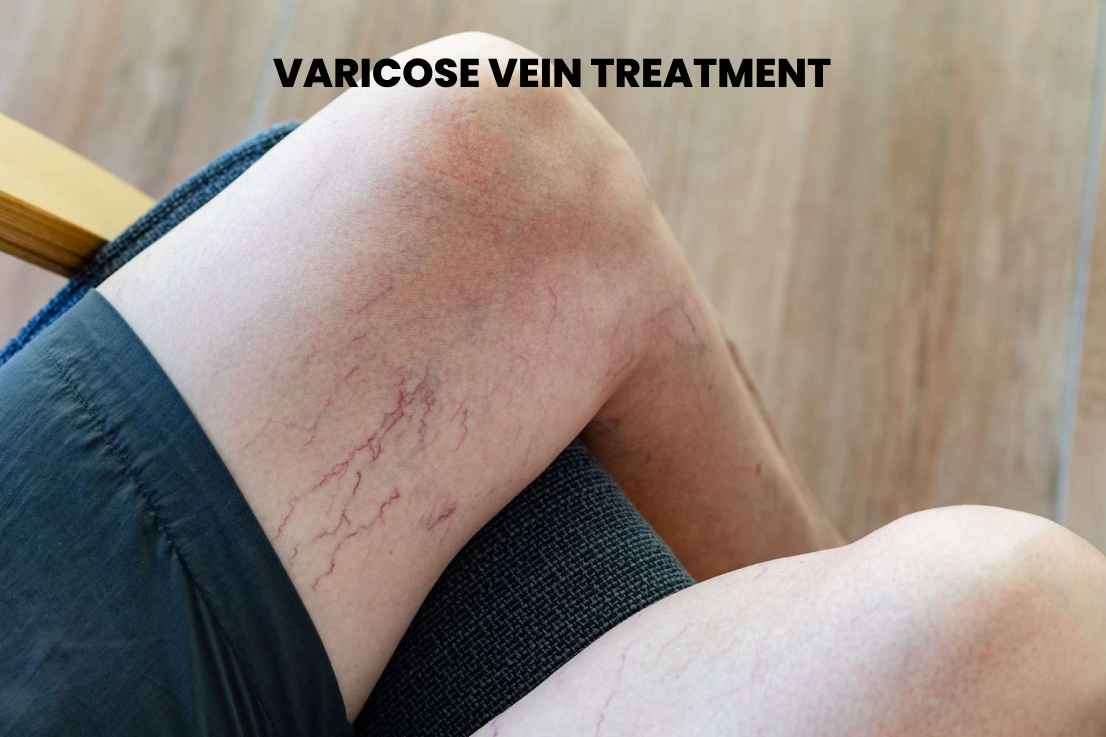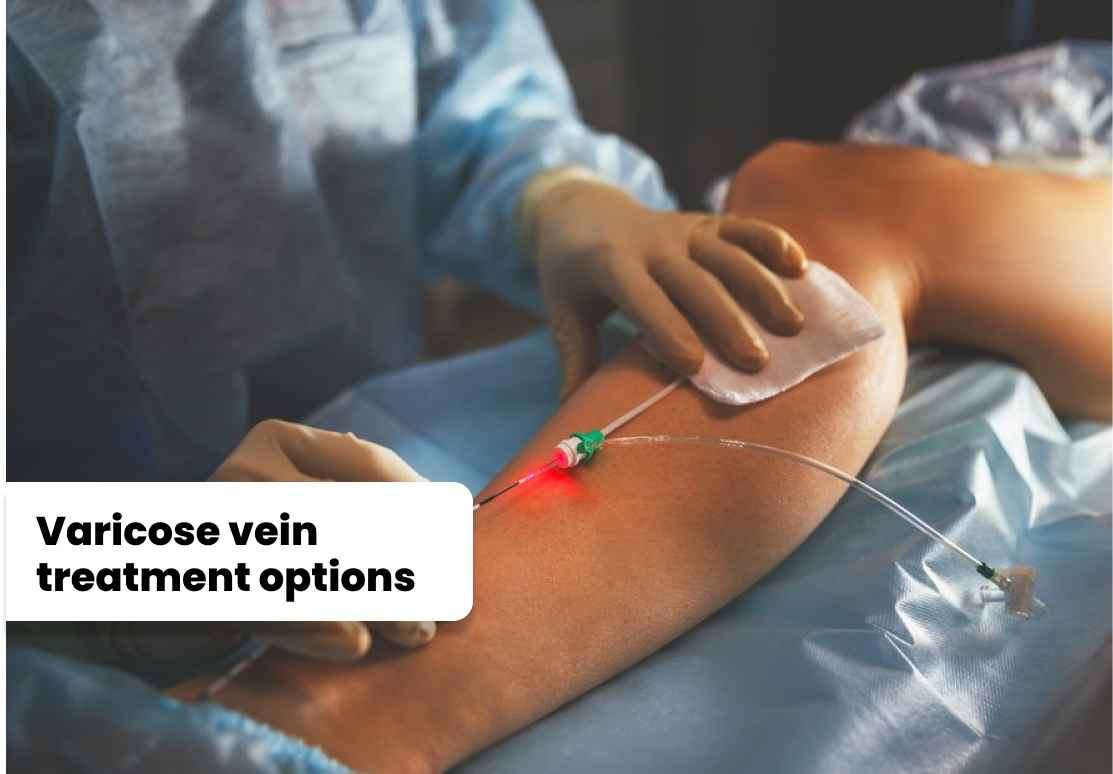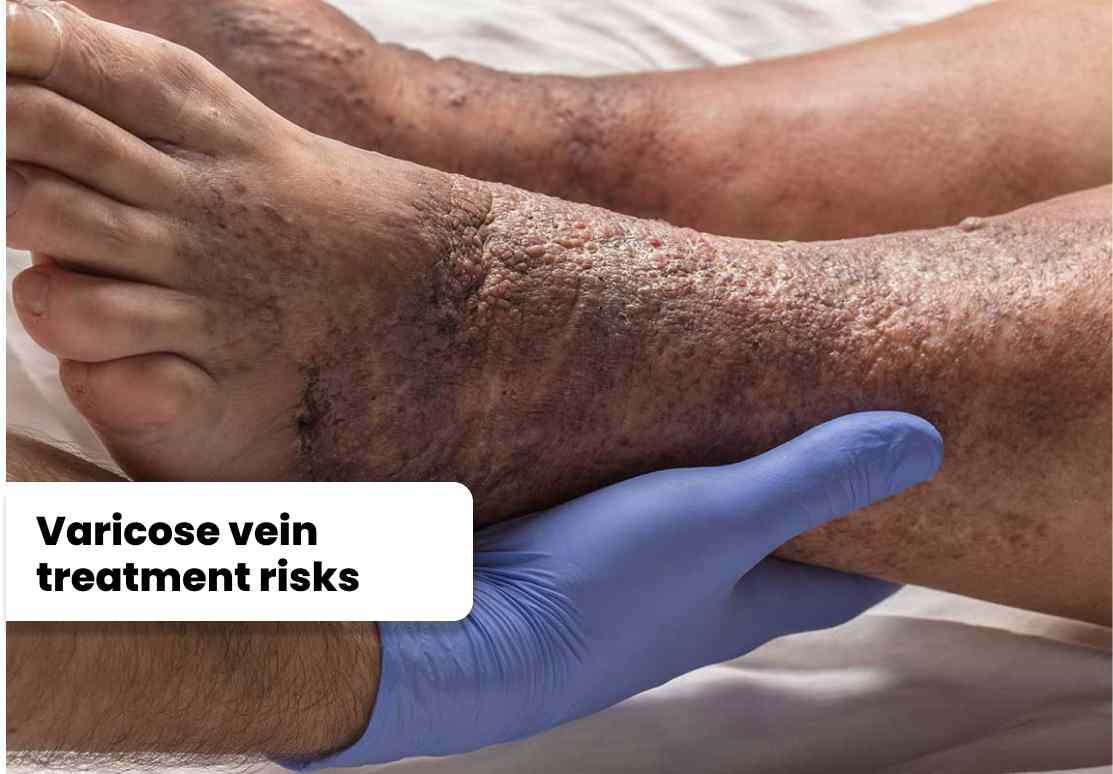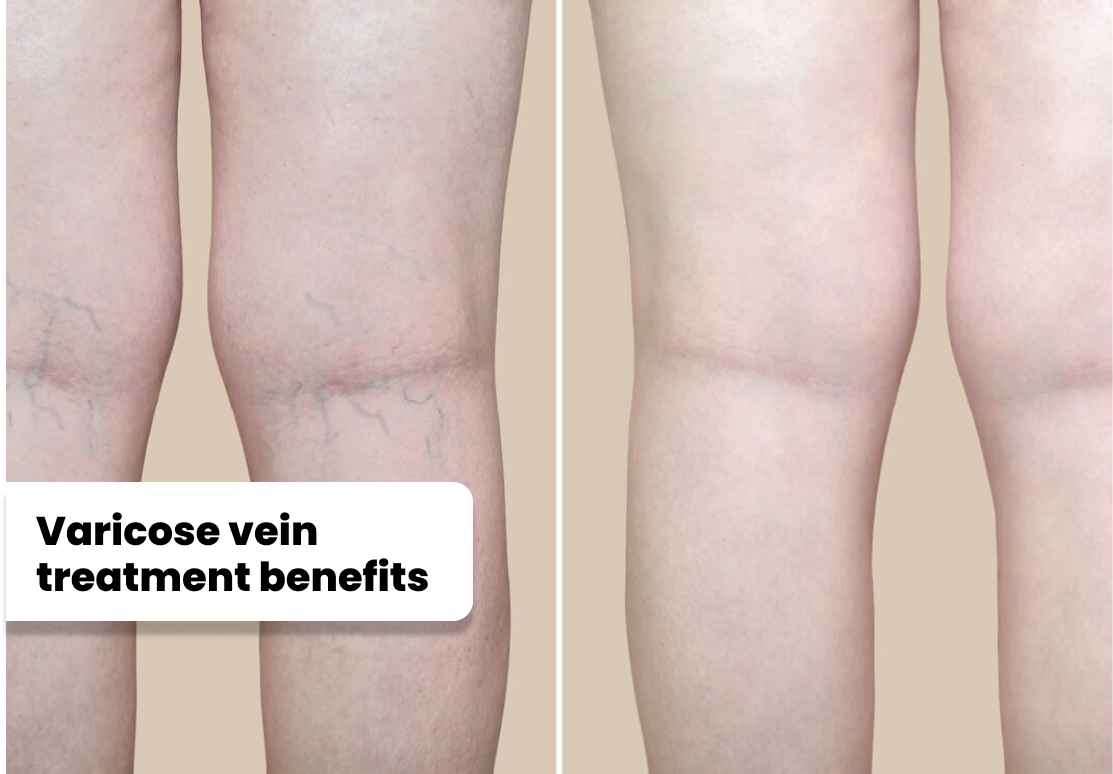
2. Sclerotherapy: Sclerotherapy is a minimally invasive
procedure commonly used to treat varicose veins. It involves injecting a
solution directly into the affected veins, causing them to shrink and
eventually fade away. Sclerotherapy is often used for smaller varicose veins
and spider veins. The procedure is virtually painless, requires no anesthesia,
and allows individuals to resume normal activities shortly after treatment. 3. Endovenous Laser Ablation (EVLA): Endovenous Laser Ablation, also known as
endovenous laser treatment (EVLT), is a highly effective and minimally invasive
procedure for treating larger varicose veins. It involves inserting a laser
fiber into the damaged vein, which emits laser energy to heat and seal the vein
shut. The sealed vein gradually disappears over time, and blood flow is
redirected to healthier veins. EVLA is performed under local anesthesia and
offers excellent results with minimal scarring and downtime. 4. Radiofrequency Ablation (RFA): Radiofrequency Ablation is a procedure similar
to EVLA in its objective, but it uses radiofrequency energy instead of laser
energy. The heat generated by the radiofrequency waves causes the vein to
collapse and seal shut, diverting blood flow to healthier veins. RFA is a safe
and effective treatment option, often performed on an outpatient basis, and
offers quick recovery times. 5. Ambulatory Phlebectomy: Ambulatory Phlebectomy is a surgical technique
used to remove superficial varicose veins through small incisions. The
procedure is typically performed under local anesthesia, and the incisions made
are so small that stitches are usually not required. Ambulatory Phlebectomy is
effective for treating larger varicose veins close to the skin's surface and
provides long-term results. 6. High Ligation and Stripping: High ligation and stripping is a surgical
procedure that involves tying off the affected vein and removing it through
small incisions. While it is considered a more invasive option compared to
other treatments, it may be recommended for severe cases of varicose veins. The
procedure is performed under general anesthesia, and recovery time is longer
than with non-surgical treatments.

2. Sclerotherapy: Sclerotherapy is a minimally invasive procedure commonly used to treat varicose veins. It involves injecting a solution directly into the affected veins, causing them to shrink and eventually fade away. Sclerotherapy is often used for smaller varicose veins and spider veins. The procedure is virtually painless, requires no anesthesia, and allows individuals to resume normal activities shortly after treatment.
3. Endovenous Laser Ablation (EVLA): Endovenous Laser Ablation, also known as endovenous laser treatment (EVLT), is a highly effective and minimally invasive procedure for treating larger varicose veins. It involves inserting a laser fiber into the damaged vein, which emits laser energy to heat and seal the vein shut. The sealed vein gradually disappears over time, and blood flow is redirected to healthier veins. EVLA is performed under local anesthesia and offers excellent results with minimal scarring and downtime.
4. Radiofrequency Ablation (RFA): Radiofrequency Ablation is a procedure similar to EVLA in its objective, but it uses radiofrequency energy instead of laser energy. The heat generated by the radiofrequency waves causes the vein to collapse and seal shut, diverting blood flow to healthier veins. RFA is a safe and effective treatment option, often performed on an outpatient basis, and offers quick recovery times.
5. Ambulatory Phlebectomy: Ambulatory Phlebectomy is a surgical technique used to remove superficial varicose veins through small incisions. The procedure is typically performed under local anesthesia, and the incisions made are so small that stitches are usually not required. Ambulatory Phlebectomy is effective for treating larger varicose veins close to the skin's surface and provides long-term results.
6. High Ligation and Stripping: High ligation and stripping is a surgical procedure that involves tying off the affected vein and removing it through small incisions. While it is considered a more invasive option compared to other treatments, it may be recommended for severe cases of varicose veins. The procedure is performed under general anesthesia, and recovery time is longer than with non-surgical treatments.
2. Bruising and Swelling: It is common to
experience some bruising and swelling after varicose vein treatments,
particularly with sclerotherapy and ambulatory phlebectomy. These side effects
are usually temporary and subside within a few days or weeks.
3. Skin Discoloration: In some cases, treated
veins may cause temporary skin discoloration or hyperpigmentation. This usually
resolves over time, but in rare instances, it can persist. 4. Allergic Reactions: Although rare, some
individuals may experience an allergic reaction to the solutions or medications
used during sclerotherapy. It is important to inform your healthcare provider
about any known allergies before undergoing the procedure. 5. Nerve Damage:
There is a slight risk of nerve damage during varicose vein treatments,
particularly with surgical procedures like ambulatory phlebectomy and
high ligation and stripping. This risk is generally minimized by skilled
and experienced healthcare professionals.

2. Bruising and Swelling: It is common to experience some bruising and swelling after varicose vein treatments, particularly with sclerotherapy and ambulatory phlebectomy. These side effects are usually temporary and subside within a few days or weeks.
3. Skin Discoloration: In some cases, treated veins may cause temporary skin discoloration or hyperpigmentation. This usually resolves over time, but in rare instances, it can persist.
4. Allergic Reactions: Although rare, some
individuals may experience an allergic reaction to the solutions or medications
used during sclerotherapy. It is important to inform your healthcare provider
about any known allergies before undergoing the procedure.
5. Nerve Damage: There is a slight risk of nerve damage during varicose vein treatments, particularly with surgical procedures like ambulatory phlebectomy and high ligation and stripping. This risk is generally minimized by skilled and experienced healthcare professionals.
1. Symptom Relief: Varicose vein treatments can alleviate the uncomfortable symptoms associated with the condition, such as pain, heaviness, itching, and swelling. By improving blood flow and redirecting it to healthier veins, treatment can significantly improve the overall quality of life for individuals with varicose veins. 2. Enhanced Appearance: Many people with varicose veins experience self-consciousness or embarrassment about the appearance of their legs. Treatment options like sclerotherapy, endovenous laser ablation, and ambulatory phlebectomy can effectively reduce or eliminate the visible appearance of varicose veins, improving the aesthetics and boosting self-confidence. 3. Prevention of Complications: Varicose veins, if left untreated, can lead to more severe complications such as blood clots, skin ulcers, and venous bleeding. By addressing the underlying issue through treatment, the risk of developing these complications can be significantly reduced. 4. Minimal Downtime: Most varicose vein treatments are minimally invasive and performed on an outpatient basis. This means that individuals can typically resume their regular activities shortly after the procedure, with minimal disruption to their daily lives. 5. Long-Term Results: Depending on the treatment method chosen, varicose vein treatments can provide long-lasting or permanent results. While new varicose veins may develop over time, the treated veins are often effectively sealed off or removed, reducing the likelihood of recurrence.

1. Symptom Relief: Varicose vein treatments can alleviate the uncomfortable symptoms associated with the condition, such as pain, heaviness, itching, and swelling. By improving blood flow and redirecting it to healthier veins, treatment can significantly improve the overall quality of life for individuals with varicose veins.
2. Enhanced Appearance: Many people with varicose veins experience self-consciousness or embarrassment about the appearance of their legs. Treatment options like sclerotherapy, endovenous laser ablation, and ambulatory phlebectomy can effectively reduce or eliminate the visible appearance of varicose veins, improving the aesthetics and boosting self-confidence.
3. Prevention of Complications: Varicose veins, if left untreated, can lead to more severe complications such as blood clots, skin ulcers, and venous bleeding. By addressing the underlying issue through treatment, the risk of developing these complications can be significantly reduced.
4. Minimal Downtime: Most varicose vein treatments are minimally invasive and performed on an outpatient basis. This means that individuals can typically resume their regular activities shortly after the procedure, with minimal disruption to their daily lives.
5. Long-Term Results: Depending on the treatment method chosen, varicose vein treatments can provide long-lasting or permanent results. While new varicose veins may develop over time, the treated veins are often effectively sealed off or removed, reducing the likelihood of recurrence.
The cost of varicose vein treatment can vary depending on several factors, including the severity of the condition, the treatment method chosen, the number of veins being treated, the healthcare facility, and the region or city in which the treatment is sought. Here is an approximate cost range for varicose vein treatment in various Indian cities:
|
Serial No |
City |
Minimum Cost (INR) |
Average Cost (INR) |
|
1 |
Mumbai |
30,000 |
80,000 |
|
2 |
Delhi |
25,000 |
70,000 |
|
3 |
Bangalore |
20,000 |
60,000 |
|
4 |
Chennai |
18,000 |
55,000 |
|
5 |
Kolkata |
15,000 |
50,000 |
|
6 |
Hyderabad |
15,000 |
50,000 |
|
7 |
Pune |
15,000 |
45,000 |
|
8 |
Ahmedabad |
12,000 |
40,000 |
|
9 |
Jaipur |
12,000 |
40,000 |
|
10 |
Chandigarh |
10,000 |
35,000 |
|
11 |
Lucknow |
10,000 |
35,000 |
|
12 |
Indore |
8,000 |
30,000 |
|
13 |
Kochi |
8,000 |
30,000 |
|
14 |
Coimbatore |
7,000 |
25,000 |
|
15 |
Bhopal |
7,000 |
25,000 |
|
16 |
Nagpur |
6,000 |
20,000 |
|
17 |
Goa |
6,000 |
20,000 |
|
18 |
Mangalore |
5,000 |
18,000 |
|
19 |
Trivandrum |
5,000 |
18,000 |
|
20 |
Guwahati |
4,000 |
15,000 |
|
Serial No |
Hospital Name |
Address |
Contact Number |
|
1
|
All India Institute of Medical Sciences (AIIMS) |
Ansari Nagar, Aurobindo Marg, New Delhi - 110029 |
+91-11-26588500 |
|
2 |
Post Graduate Institute of Medical Education and Research (PGIMER) |
Sector-12, Chandigarh - 160012 |
+91-172-2747585 |
|
3 |
Sanjay Gandhi Postgraduate Institute of Medical Sciences (SGPGIMS) |
Rae Bareli Road, Lucknow, Uttar Pradesh - 226014 |
+91-522-2668700 |
|
4 |
JIPMER (Jawaharlal Institute of Postgraduate Medical Education and Research) |
Dhanvantari Nagar, Puducherry - 605006 |
+91-413-2296000 |
|
5 |
Sree Chitra Tirunal Institute for Medical Sciences and Technology (SCTIMST) |
Medical College P.O., Thiruvananthapuram, Kerala - 695011 |
+91-471-2524266 |
|
6 |
King George's Medical University (KGMU) |
Chowk, Lucknow, Uttar Pradesh - 226003 |
+91-522-2257450 |
|
7 |
Nizam's Institute of Medical Sciences (NIMS) |
Punjagutta, Hyderabad, Telangana - 500082 |
+91-40-23489000 |
|
8 |
Government Medical College and Hospital (GMCH) |
Sector 32, Chandigarh - 160030 |
+91-172-2601023 |
|
9 |
Institute of Medical Sciences (IMS), Banaras Hindu University (BHU) |
Lanka, Varanasi, Uttar Pradesh - 221005 |
+91-542-2367568 |
|
10 |
Osmania General Hospital |
Afzal Gunj, Hyderabad, Telangana - 500012 |
+91-40-24600146 |
Please Wait..